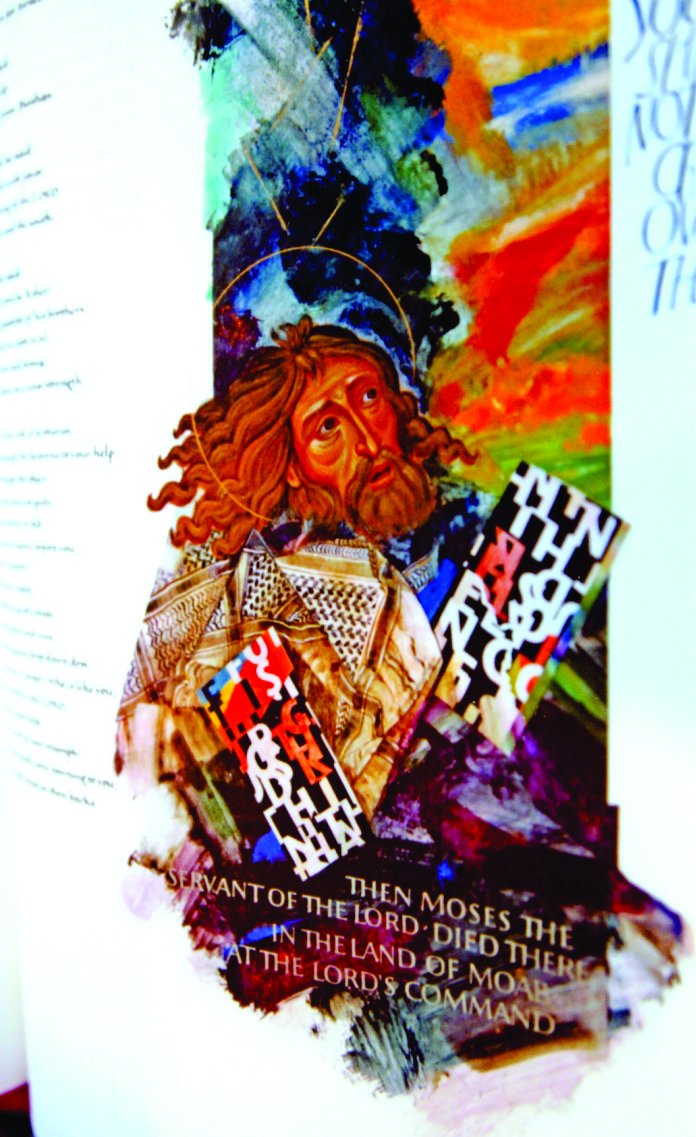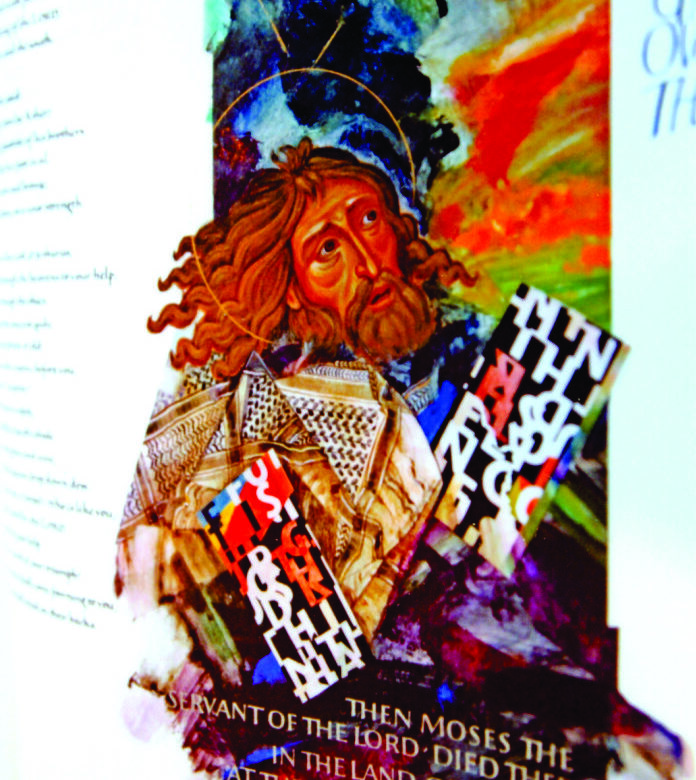Other news
The Bible That is Also a Work of Art
Richard Watts
Volume 28 Issue 4, 5 & 6 | Posted: June 30, 2014

An edition of the St. John’s Bible, combining resurrected techniques from the Middle Ages with modern art and images, has a new home in Victoria.
The arrival of the book, the first hand-written, illuminated Bible created in more than 500 years, is a result of a birthday project initiated by Rev. Remi De Roo, the former Roman Catholic bishop of Victoria, who turned 90 on February 24th.
Presenting the Bible at the Greater Victoria Public Library Central branch, De Roo said when he first heard of the making of the St. John’s Bible: Heritage Edition his response was immediate: “I want one for the West Coast.”
An edition of the St. John’s Bible, combining resurrected techniques from the Middle Ages with modern art and images, has a new home in Victoria.
The arrival of the book, the first hand-written, illuminated Bible created in more than 500 years, is a result of a birthday project initiated by Rev. Remi De Roo, the former Roman Catholic bishop of Victoria, who turned 90 on February 24th.
Presenting the Bible at the Greater Victoria Public Library Central branch, De Roo said when he first heard of the making of the St. John’s Bible: Heritage Edition his response was immediate: “I want one for the West Coast.”
Its ownership will be handed over to the University of Victoria Centre for Studies in Religion and Society. It was also lent to consecrate the new bishop of the Anglican Diocese of British Columbia, Logan McMenamie, at Christ Church Cathedral on March 2nd.
The St. John’s Bible is a creation of St. John’s Benedictine Abbey and University in Collegeville, Minn. It was commissioned in 1998 to be the first handwritten Bible created since the introduction of the printing press in the 15th century.
The original project was completed by a team of six calligraphers, who worked in Wales for 15 years. Old-style instruments and materials were used, such as bird-quill pens on calf-skin vellum pages. It cost about $8 million.
There are seven volumes, 1,151 pages and the work contains the full New Revised Standard Version of the Bible. It has hundreds of illustrations, including 160 illuminations, major artworks decorated with real gold and silver.
There are 299 Heritage Editions. They are printed versions of the original now kept at St. John’s Abbey. Each seven-volume set costs $155,000.
Jim Triggs, executive director of the heritage program at St. John’s University, here to present the first three volumes of the Victoria set, said it would be an error to regard the printed Heritage Editions as mere copies. Each is a work of art in its own right.
For example, Triggs said, the chief calligrapher, Englishman Donald Jackson, was entranced by the play of light on illuminations as pages are turned.
“He designed each of these pages so you can get a real sense of the dynamic play of light across them as you turn the pages,” Triggs said.
Also, calf-skin vellum has a translucent quality not found in the heavy-stock, cotton-fibre paper of the Heritage Editions. Jackson wanted to maintain the sense of anticipation when looking through a translucent vellum page to the outline of an illustration on the other side, so printers were instructed to use water-colour techniques to create faint outlines of the artwork on the opposite side of the pages.
“It gives you a sense of the translucence of vellum,” Triggs said. “So if something big is coming as you turn the pages, there is a little sense of drama.”
Six artists around the world were commissioned. Each was encouraged to use modern imagery. As a result, figures such as cars and the World Trade Centre can be found in pieces.
The St. John’s Bible and its artwork reflect a 21st-century sensibility, celebrating ideas such as equality of women.
The Book of Matthew begins with a long series of “begats” to establish Jesus’s links to Abraham, but offers only a few women’s names. So a team of historians and scholars provided women’s names to be included in the accompanying art.
In the same piece, the artist included Hebrew and Arabic script to maintain a modern, multicultural sense. There is even a double helix, the DNA molecule, indicating an appreciation of science. “There is also theological purpose to it, since we believe Jesus was truly human and therefore we share some of his DNA,” Triggs said.
 Prof. Paul Bramadat, director of UVic’s Centre for Studies in Religion and Society, said the St. John’s Bible will make an excellent resource for modern scholars. “Every tradition is constantly trying to build bridges between the past and the present,” Bramadat said. “Jewish, Muslim, Christian, Buddhist it is a perennial, universal challenge.
Prof. Paul Bramadat, director of UVic’s Centre for Studies in Religion and Society, said the St. John’s Bible will make an excellent resource for modern scholars. “Every tradition is constantly trying to build bridges between the past and the present,” Bramadat said. “Jewish, Muslim, Christian, Buddhist it is a perennial, universal challenge.
“The fact that this [St. John’s Bible] process has been so masterful in its execution and so sophisticated in its theology makes it a real high-water mark.”
For more information, go to saintjohnsbible.org. To donate money to help bring the remaining four volumes to Victoria, send a donation to UVic and designate St. John’s Bible in the memo space.
Richard Watts

